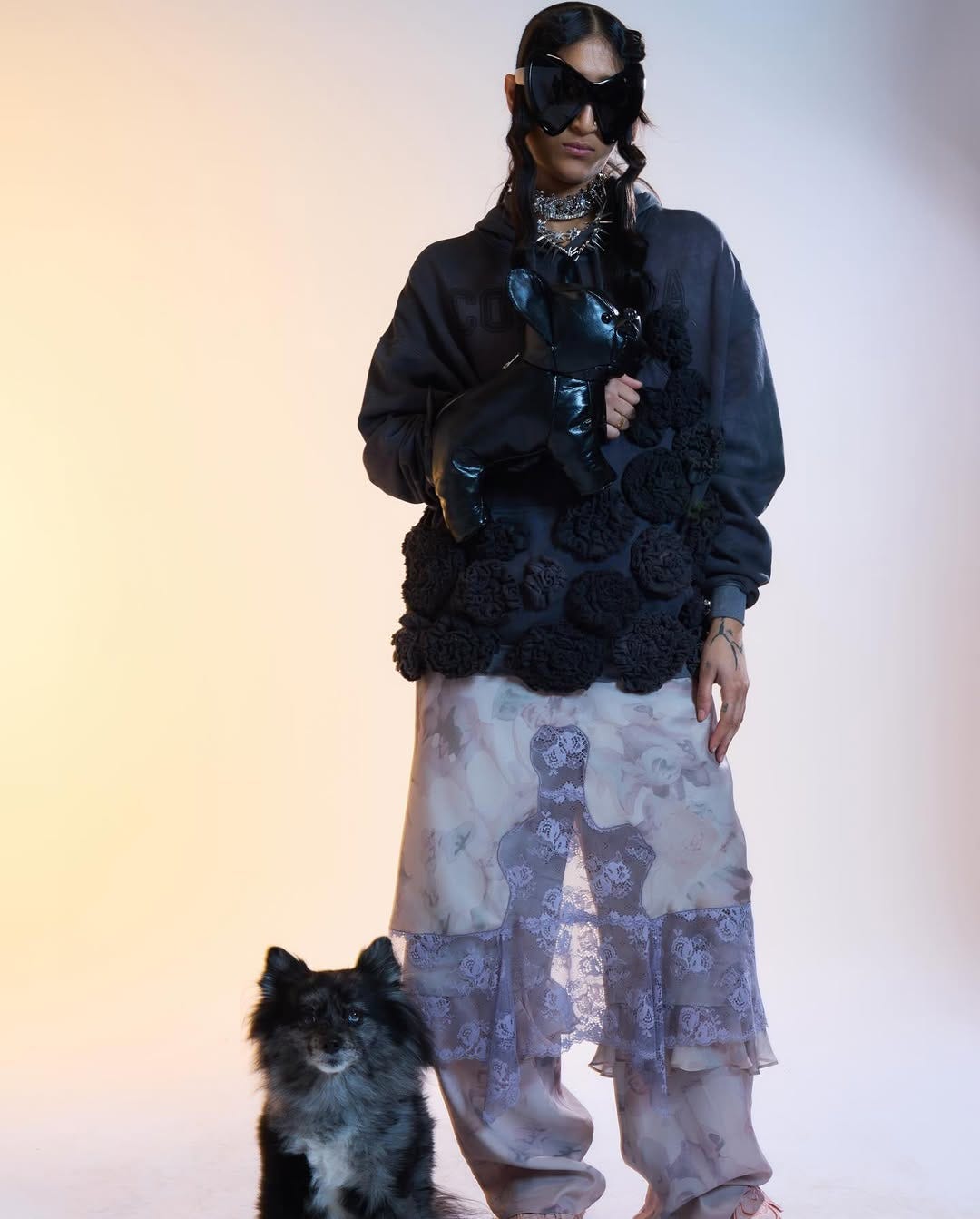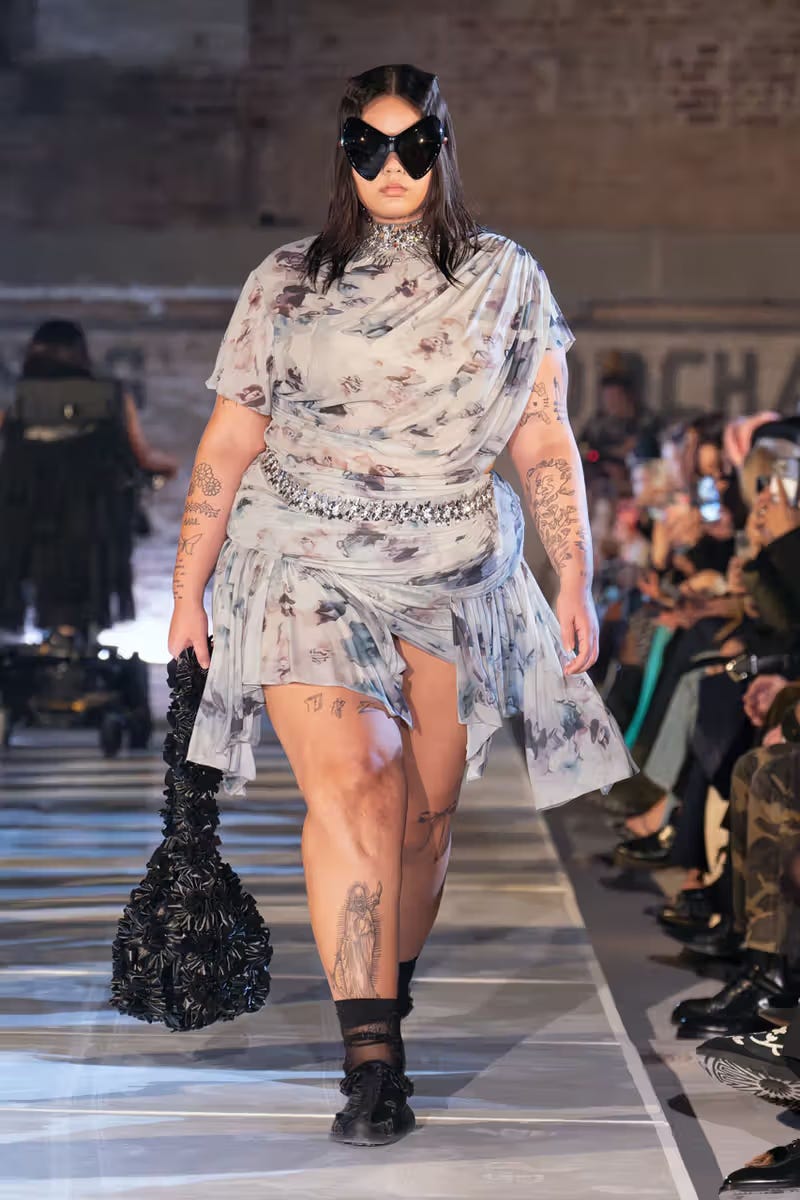Collina Strada Partners With TômTex to Make the Meatiest Vegan Accessories We’ve Ever Seen
A Q&A with designer Hillary Taymour and designer Uyen Tran
Last April, I attended a panel at The Standard on sustainable fashion and biofabrication. I heard Uyen Tran, CEO of TômTex, and Hillary Taymour, Creative Director of Collina Strada, share their perspectives on sustainability in fashion. I remember giggling at Hillary’s Pomeranian, Powwie, lounging in her lap as we learned about her efforts to repurpose textile waste in Accra, Ghana. I’d be chill like that if my mom were a sustainable fashion icon, too. I also remember being gagged by a Dauphinette mushroom leather bag Uyen passed around the room that had been marbled to look like raw meat. I love it when fashion lies to me for the better.
A year later, Collina Strada’s FW25 collection, Fempire, featured vegan accessories made in collaboration with TômTex (including some canine-shaped pieces–maybe Powwie was at The Standard on business, too). While Hillary explores femininity and its many intersections—jagged, soft, round, and everything in between—at Collina Strada, Uyen is pushing the limits of biomaterials in ways that could truly revolutionize the fashion industry. We sat down with both Hillary and Uyen to learn how their partnership culminated. These pieces are a glimpse into the future: intuitive, full of spirit, soft where it's unexpected, and shaped by the serendipity of happy accidents that create real change.
Sustainable Baddie: Fempire is rooted in themes of empowerment and transformation. How did your collaboration with TômTex help bring this vision to life?
Hillary Taymour: Fempire is all about stepping into power while embracing fluidity—breaking things down to rebuild them stronger, and better. TômTex is literally transformation in material form. It takes waste and turns it into something luxurious and future-facing. It’s proof that we don’t have to rely on old systems or harmful materials to make something beautiful and expressive. That ethos aligned perfectly with what we were building this season.
SB: Sustainability has always been a key part of Collina Strada’s ethos. How did working with biodegradable materials influence your creative process this season?
HT: Sustainability isn’t just a checkbox—it’s a mindset that constantly pushes creativity. With TômTex, we were working with a material that has its own voice, its own behavior. It forced us to be more intuitive, to let go of certain expectations and instead lean into what the material wanted to do. That’s the kind of challenge that makes design exciting.
SB: The scrunchie bag and dog hand purse embody the sharper, more sculptural aspects of the collection, yet they are made from a material with an inherently soft nature. What drew you to use TômTex materials for these pieces, and what do they bring to the overall aesthetic of Fempire?
HT: I love playing with contrast—soft versus structured, organic versus synthetic-looking. TômTex has this beautiful malleability, almost like leather but without the weight of its impact. It let us sculpt these exaggerated, playful shapes while staying true to the ethos of the collection. The dog hand purse especially—it’s cheeky, it’s unexpected, but it also showcases how these materials can be used in ways that feel high fashion and yet are deeply conscientious.
SB: Some of this collection draws inspiration from heirloom wedding dresses and even uses thrift store finds. How do you balance working with these found materials while integrating new biomaterials like TômTex?
HT: It’s about honoring the past while building the future. The heirloom and thrifted pieces bring history and emotional weight, while TômTex represents possibility and innovation. When you mix them, it creates this dialogue between eras—something nostalgic but not stuck, romantic but not traditional. That balance is where the magic happens.
SB: Were there any unexpected challenges or discoveries while working with TômTex for this collection?
HT: For sure—every new material comes with a learning curve. TômTex has a unique texture and way of holding structure, so we had to test different ways of sewing and molding it. But that’s the fun part. There were moments when we thought something wouldn’t work, and then suddenly it did in a way that felt even better than what we planned. It’s all part of the process.
SB: As a designer, how do you see the role of sustainable materials evolving in the industry? What do you hope this collab signals to others about the future of design?
HT: Sustainable materials aren’t a trend—they’re the future. The industry has no choice but to adapt, and I want this collab to show that sustainable options don’t have to be limiting. They can be weird, they can be exciting, they can be luxurious. I hope it inspires other designers to experiment, to push boundaries, and to rethink what’s possible. Because once you see what’s out there, there’s really no excuse to keep using harmful materials.
SB: TômTex is redefining sustainable textiles with its Chitosan-based biomaterial. What makes these materials well-suited to fashion, and how do they compare to conventional alternatives?
Uyen Tran: At TômTex, we believe that the future of fashion is rooted in nature. Our biomaterial—made from chitosan, one of the most abundant biopolymers on Earth—offers a fully biodegradable and plastic-free alternative to traditional leather and synthetic textiles. Unlike conventional materials that rely on petrochemicals or resource-intensive production, TômTex is lightweight, customizable, and can be molded into intricate textures without the need for harmful chemicals. It’s designed to integrate seamlessly into the fashion industry, allowing designers to create luxurious, high-performing pieces while reducing their environmental impact.
SB: This marks your second season working with Collina Strada. What excites you most about working with designers like Hillary?
UT: Hillary has an incredible ability to merge playfulness with purpose, creating collections that are both visually striking and deeply rooted in sustainability. Working with Collina Strada again is exciting because it allows us to push the boundaries of biomaterial applications in high fashion. Hillary embraces innovation, which gives us the creative freedom to experiment with textures, colors, and finishes that highlight the material’s unique qualities. Seeing our material come to life on the runway in such an expressive way is truly inspiring.
SB: TômTex is committed to creating materials that mirror nature's lifecycle. How does that philosophy align with the themes of Collina Strada’s FW25 collection?
UT: Our philosophy is all about circularity—designing materials that can return to the earth without leaving a trace. Collina Strada’s FW25 collection explores themes of transformation, renewal, and connection to the natural world, which aligns perfectly with our approach to material innovation. Just as the collection reimagines traditional fashion through an eco-conscious lens, our biomaterial challenges the industry’s reliance on plastic-based textiles. It’s a collaboration that proves sustainability and creativity can go hand in hand.
SB: Based on your experience, what are the biggest misconceptions about sustainable materials, and how is TômTex working to change that narrative?
UT: Many assume sustainable materials are fragile, restrictive, or a compromise—but that’s outdated thinking. At TômTex, we’re proving that biomaterials can be just as durable, luxurious, and high-performing as traditional options, without plastic or petrochemicals. Sustainability isn’t a limitation; it’s an evolution.
SB: What biomaterial innovation are you most excited to explore next?
UT: At TômTex, we’re building a whole new family of next-gen materials designed to replace synthetic textiles at every level. Beyond just fabric, we’re developing bio-based adhesives and finishes to create a fully integrated, plastic-free ecosystem for the industry. Our goal is not just to offer an alternative—but to redefine the standard, ensuring every component, from texture to durability, meets the needs of fashion, automotive, and beyond.












I love Hillary’s philosophy of letting the materiel lead. Such an important consideration!!